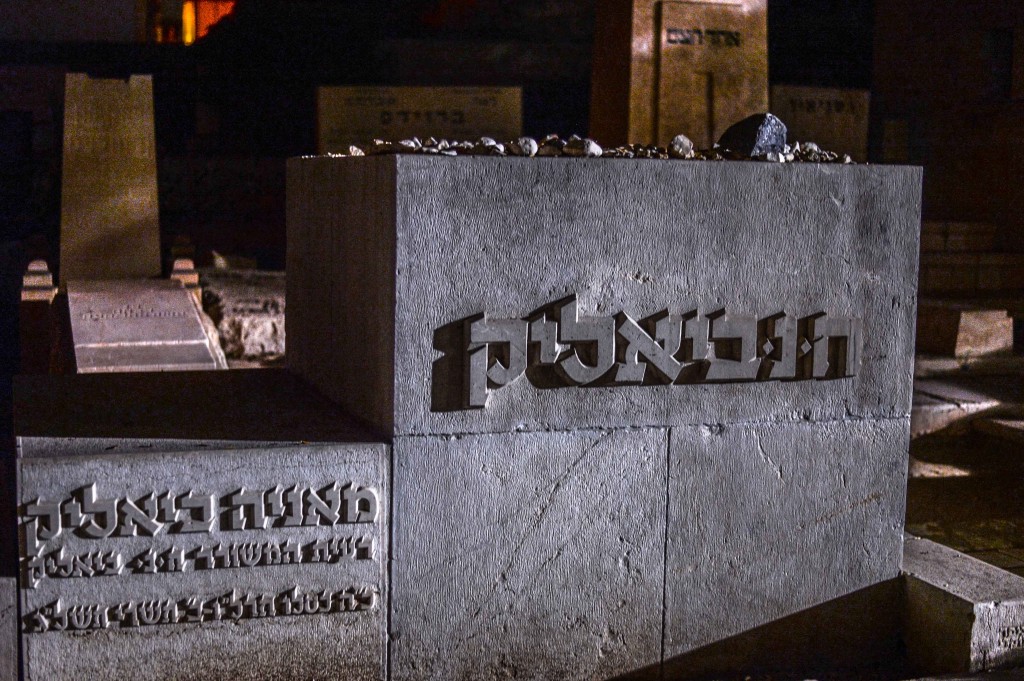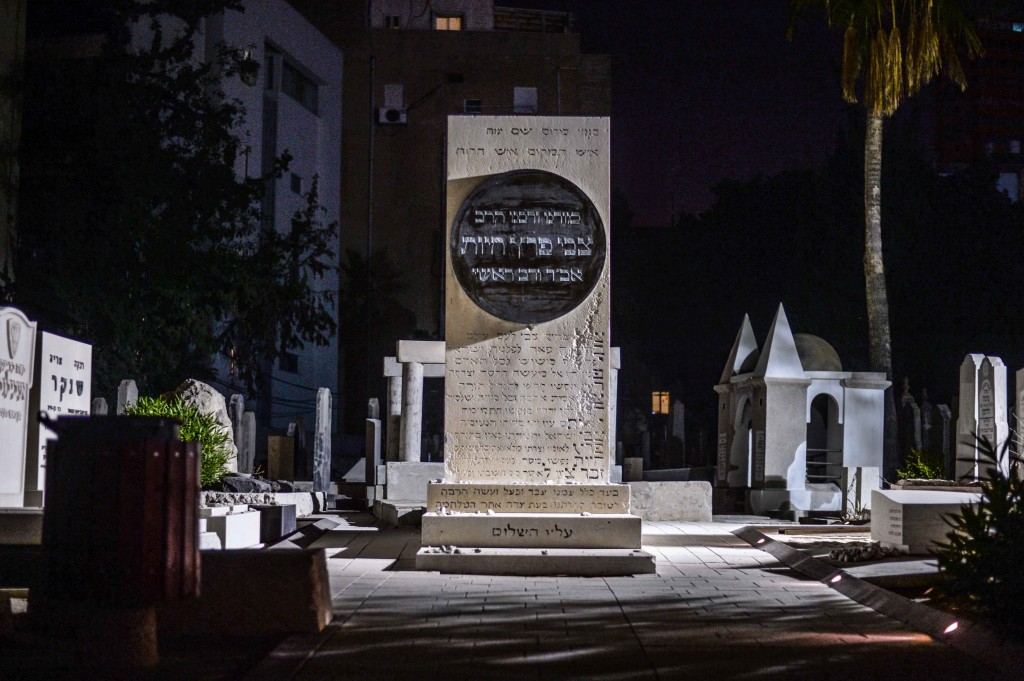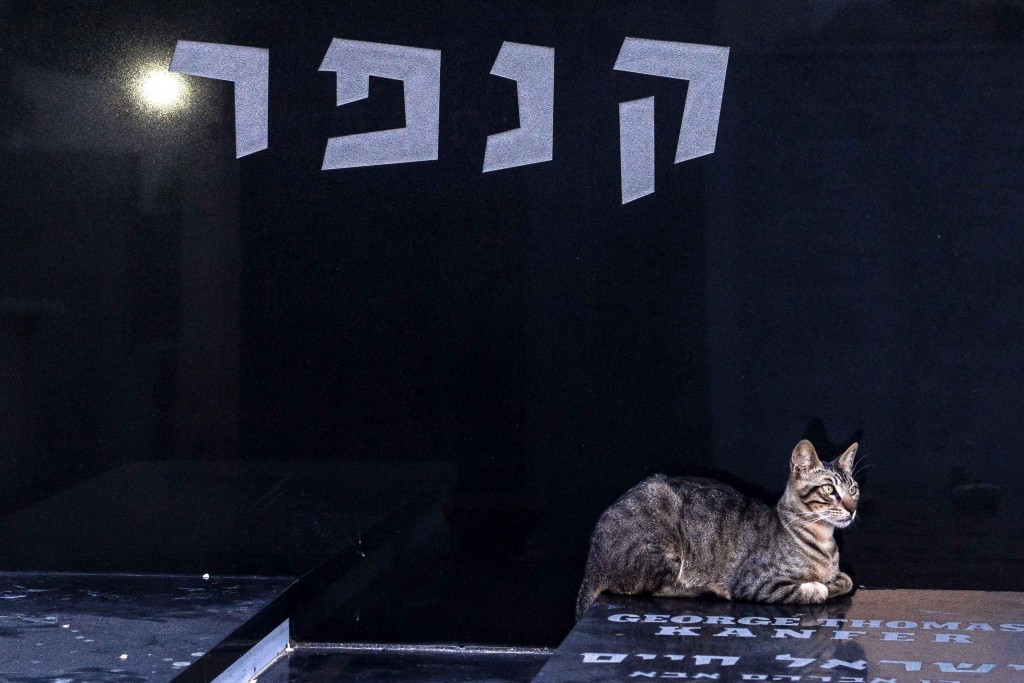In a quiet corner of Israel’s most secular city lies holy ground: a cemetery containing some of the greatest leaders of the nascent Jewish State. Amid the quietude, you can feel the presence of the Great Ones of Israel, still steering the country’s path. Photos: Aviram Valdman
Hidden on a small side street between the central thoroughfares of Ben-Yehuda and Dizengoff Streets lies one of the jewels of Tel Aviv; a quiet tribute to the first Hebrew city in over 2,000 years and the men who made it. It is a valley of giants, and they speak softly from among the graves of Trumpeldor Cemetery.
Trumpeldor Cemetery takes up most of the small and usually overlooked street from which it takes its name. Surrounded and mostly concealed by a stone wall with only three small gates, only one of which is ever left open, it is easy to pass by it without a second thought. Indeed, I myself found it purely by chance, when a random sideways glance through one of the gates revealed a huddled mass of gravestones rising up a small hill.
The sight was so unusual in a city whose graveyards generally lie far to its eastern suburbs that it instantly aroused both wonder and curiosity. So it was, in effect, completely accidental that I entered the main gate and discovered the resting place of what the cemetery’s official webpage calls “gedolei yisrael”—the Great Ones of Israel. The phrase, in this case, is something of an understatement.
Hevrah Kadisha, the institution that operates the cemetery, says it best,
This stone wall encloses… the most miraculous chapter of a shining era in the Jewish people’s renewal in the Land of Israel. On this site are… witnesses inscribed in stone to a chapter in the history of the New Yishuv [the pre-state Palestinian Jewish community] inscribed in stone. The graves here are not only isolated markers of the great ones of the people, but a general monument to the extraordinary creators of a people’s renewal on their land. Here found their eternal rest rabbis, admired poets, great ones of thought and action, founders and leaders of the Hebrew city, writers, and businessmen, who through their activism and the spiritual burden they shouldered, defined the image and the path of the renewed Jewish yishuv. This cemetery is also sanctified by the blood of defenders and martyrs who gave their lives for the honor and security of the yishuv, and are interred here in collective graves.
That Trumpeldor Cemetery stands a monument to this “shining era” should not be surprising, given its history. Indeed, it is older than Tel Aviv itself; and was, in many ways, the first step toward the great city that slowly grew up around it and now surrounds it on all sides. Once it lay in a barren area north of Jaffa; now it stands as the almost invisible heart of a metropolis that those interred beneath its stones envisioned.
Trumpeldor Cemetery was established in 1902, a full seven years before the first neighborhoods of what would become Tel Aviv were constructed. Its immediate cause was both practical and tragic: An epidemic struck the city of Jaffa—the ancient city that gave birth to its northern neighbor—and the old Jewish cemetery proved unable to accommodate the number of victims. At the same time, in a bid to fight the spread of the epidemic, the ruling Ottoman authorities decreed that none of the victims—Jewish or Arab—could be buried within the city limits. Separate plots were allocated for each community, and businessman Shimon Rokeach, a prominent member of Jaffa’s Jewish community—who eventually became the second mayor of Tel Aviv—supervised the establishment of the new cemetery on 12 dunams north of the city. By the time the British conquered Palestine during World War I and established the British Mandatory government, the cemetery had already become the primary burial place for the Jews of Jaffa and the nascent Tel Aviv.
Suitably, Rokeach himself now lies in the southwest corner of the cemetery, which was once open to the sea before the hotels, seaside homes, offices, and nightclubs that form the city skyline closed it in. And it is there that all the Great Ones lie.
Indeed, the cemetery’s southwest corner is almost a shrine unto itself. Whereas the rest of the site is so tightly packed with gravestones that, at times, it becomes almost impossible to navigate, the Great Ones’ corner is almost spacious, and the stones possess a monumental quality suited to those interred beneath them. There is the pink stone monolith bearing the name of Ahad Ha’am, the founder of cultural Zionism and prophet of a renewed Hebrew culture in the Land of Israel. Despite being at least a meter higher than the average man, its top is covered in the small stones that constitute one of the traditional Jewish rituals expressing reverence toward the dead.
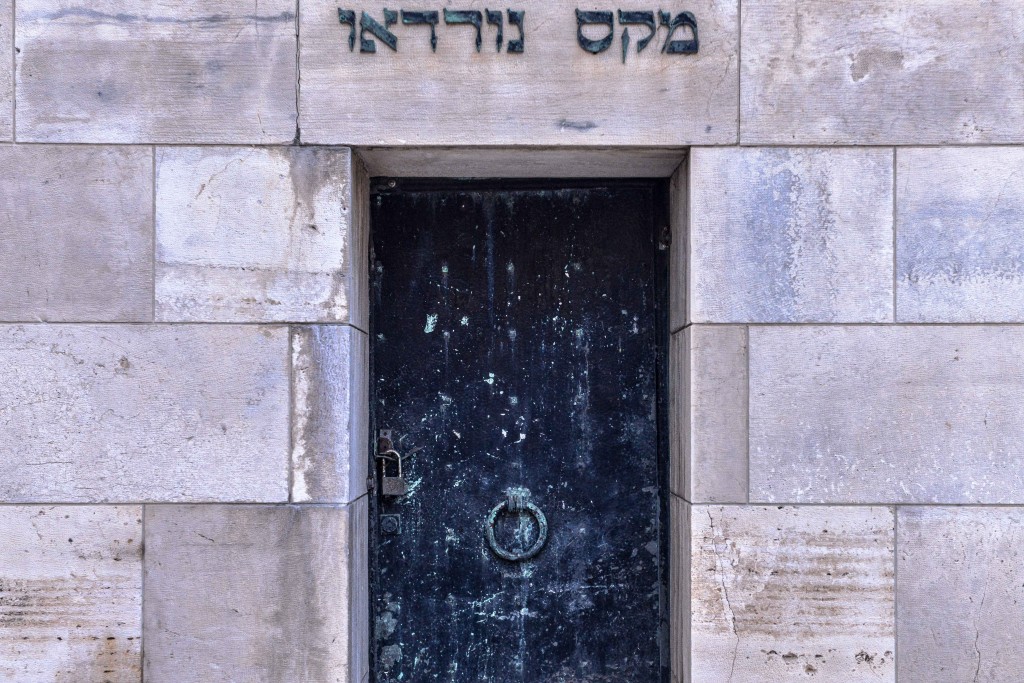
Tomb of Max Nordau, one of the seminal leaders of the early Zionist movement. Photo: Aviram Valdman / The Tower
To its right are the tombs: Three massive interconnected mausoleums that house the remains of Max Nordau, Meir Dizengoff, and Shaul Tchernichovsky. In a sense, these men belong together, as all three were pioneers in three separate spheres: Politics, urban development, and culture.
Nordau was the son of a Hebrew poet and a ferocious critic of modern trends in European culture. But he found his place in history when he became the informal second-in-command to Theodor Herzl, the legendary father of political Zionism. Like Herzl, he was devastated by the Dreyfus Affair and came to believe that the only solution to Jewish dislocation and suffering was a “muscular Judaism” embodied in a Jewish state. Together with Herzl, he helped found the World Zionist Congress, the organization that began the process of legitimizing the eventual creation of a Jewish national homeland.
Dizengoff, who gave his name to the street that encloses the eastern side of the cemetery, is in many ways the father of Tel Aviv—a realization of Herzl’s vision of a great “White City” by the sea. A farsighted entrepreneur, businessman, and municipal leader, he helped found the first Jewish neighborhoods north of Jaffa, and began the process of building a municipal infrastructure suited to a great city before that city even had a name. When Tel Aviv was officially established, he became its first mayor, and spent the rest of his life in its service, steering the young metropolis through both crisis and triumph.
Tchernichovsky was, in many ways, the most enigmatic and talented of the three. Trained as a physician, he became one of the fathers of modern Hebrew poetry, helping to transform the ancient tongue into a great modern literary language without abandoning its ancient roots. At the same time, he sought to synthesize modern Hebrew with the Western tradition, and his translations of the Homeric epics are still in print and widely regarded as canonical.
Lying diagonally to the left of Tchernichovsky is perhaps one of the few men who managed to outdo him. Eighty years after he was laid to rest among the Great Ones, Chaim Nachman Bialik remains Israel’s national poet, by far the most respected and influential pioneer of modern Hebrew. His work encompassed everything from prose and poetry to children’s books, and his goal of combining the entire history of the Hebrew language with Zionism’s revival of Jewish culture is embodied in the extraordinary home he built just ten minutes away from where he now lies. It is laden with manuscripts and books, along with extraordinary blue and white mosaics depicting biblical scenes and Jewish symbols.
Yet Bialik’s great gift lay in his capacity to articulate his people’s most fervent emotions: Their hope, their will to survive, their pride in their heritage, their passion for renaissance, and perhaps more than anything else, their anger at the suffering imposed on them by exile and statelessness. His poem “In the City of Slaughter,” written in the aftermath of a brutal pogrom, remains perhaps the most shattering articulation of Zionist anger ever written. A howling cry of rage, it goes so far as to indict God himself. “If there be justice,” Bialik wrote, “let it appear now! / But if only after my destruction from under heaven / justice should appear / Let the throne be hurled down forever!” The passage of eight decades has not dimmed his power or the reverence with which he is regarded; like Ahad Ha’am, his grave remains laden with stones.
Other giants of culture lie scattered across the cemetery, including Max Brod, who wrote himself into 20th century literary history by disobeying his friend’s dying wish. Instead of destroying Franz Kafka’s unpublished manuscripts as requested, Brod brought them to Palestine and saw to their editing and publication by the still active Shocken publishing house—the family today owns the highbrow Israeli daily Haaretz—giving the world masterpieces of German-Jewish literature like The Castle and The Trial.
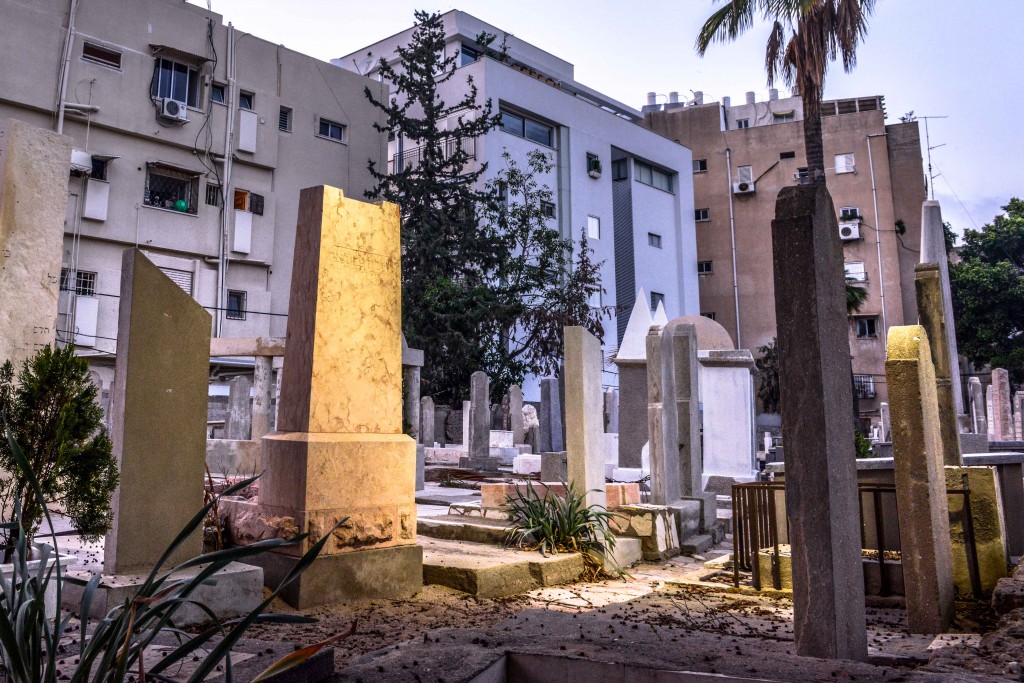
Trumpeldor Cemetery lies in an undescript residential neighborhood. Photo: Aviram Valdman / The Tower
A more recent arrival is Arik Einstein. One of Israel’s greatest singer-songwriters, Einstein helped modernize Israeli pop music, creating the soundtrack of a generation. His rich, mellifluous voice betrayed a shy and retiring personality that suffered from stage fright and preferred to keep out of the public eye. Yet when he died in November 2013, the country went into mourning more fit for a great statesman than an aging pop star.
There are other fathers of the city present, including Chaim Arlozoroff, an early Zionist leader and advocate of reconciliation with the Arabs who was murdered on the Tel Aviv beach in a still-unsolved and controversial assassination. Israel’s divisions and their sometimes violent outcome, his marker reminds us, are not nearly as new as we would like to think.
He is joined by Menachem Shenkin, the man who gave Tel Aviv its name and then gave his own name to one of the city’s most fashionable streets. He too, in his own way, was a tragic figure, dying in a car accident in the United States, very far indeed from the city he named. All lives, he seems to remind us, end messy, unfinished, and sad.
And then there is Josef Chaim Brenner, another pioneer of Hebrew literature whose presence points to one of the other unique aspects of Trumpeldor Cemetery: The mass graves.
The Hebrew term is kever achim, literally “grave of brothers.” It is a more fitting name, perhaps, than “mass graves,” which brings to mind a pit into which bodies are unceremoniously hurled. But the mass graves at Trumpeldor are delicate shrines, monuments to the collective suffering of the Jewish people.
The largest is the first thing one sees upon entering the cemetery. A long, slanted row of stones, it takes up almost half the width of the site, and is adorned with the names of those slaughtered in the 1921 Jaffa riots. This eruption of slaughter, in which Jaffa’s Arabs went on a rampage of murder, rape, and looting, left 47 Jews dead, including Brenner. The 1921 riots marked the beginning of mass Arab violence against the Jews of Palestine, and in its sudden eruption, random brutality, utter disregard for the unarmed and for women and children, as well as the collaboration of non-Jewish authorities, set the template for all future eruptions to come. And it is by no means alone. Also present are monuments to those murdered in riots that took place in 1929 and the Arab Revolt of 1936-39. Many of them appear to remain in unknown memories, as stones and yizkor candles still adorn them.
But the memorials to those who fell in these acts of violence are not the most striking of the collective graves. That status belongs to an extraordinary jet-black rectangle towering over the site like the famous monolith from 2001: A Space Odyssey. It marks the annihilation of an entire community—the Jews of the Polish town Zdunska Wola. After being stripped of their rights and confined to a ghetto, they were shipped to the death camp of Chelmno and murdered in 1942. The stark, enigmatic monument, bearing the names of the dead, was built in 1954 by the few survivors who came to Israel; and in its own small way stands as one of the most powerful memorials to the Holocaust I have ever seen.
The experience of Trumpeldor Cemetery and its quiet power is difficult to fully convey, but put simply, it is like nothing else in Tel Aviv or Israel as a whole. It now contains 3,378 gravestones, packed together so tightly that the cemetery has the feeling of a vast labyrinth of the dead, akin to the labyrinthine city of the living that surrounds it. By echoing that city of the living, it seems to draw one through the veil that separates the living from the dead, into another world of silence and sleep. More than once, I have been overcome by a sudden claustrophobia, as if I might never find my way back to the wrought-iron gates, and would be stranded forever in this other world.
Perhaps this is because of the cemetery’s incongruous surroundings. Like most great cities, Tel Aviv has little respect for its history. It is still young, but it has already torn up its past and remade itself many times over. To enter Trumpeldor Cemetery is to find a strange relic, a survival of another city, another place and time that has not so much remained as defied the storm of progress. It is, in other words, ghostly. To find it is much like taking a wrong turn down a Manhattan side street and discovering a piece of ancient New York among the towers of glass and concrete. If there is such a thing as an archeology of Tel Aviv, it is to be found here.
Equally striking is the diversity of gravestones that immediately draws the eye. Israeli graves are almost always uniform. They are flat, rectangular, unadorned, and bear only the names of the dead and their dates of birth and death. Trumpeldor Cemetery is something else entirely. Hevrah Kadisha notes that the move away from the traditional unadorned style (which it refers to as “Eastern”) began in 1921-22; and it has resulted in an astonishing array of designs and colors.
While there are no anthropomorphic statues, practically every other form of memorial is present. There are tall graves bearing photographs of the dead in small circular frames; something utterly alien to Jewish tradition and almost wholly unique in the Jewish state. Some stones are pure black, others white and gray. Some are carved out of marble and others out of stone. There are tombs with Greek-style columns, Egyptian-style pyramids, and Mesopotamian-style ziggurats that seem to spring forth out of the ancient past. Stone carvings of trees, leaves, and bunches of grapes speak to the agricultural ambitions of the early Zionist pioneers, a notable irony in the quintessentially urban Tel Aviv. Others are openly religious, adorned with symbols like two hands forming the gesture that accompanies the Blessing of the Cohenim; made famous worldwide as the “Vulcan salute” from Star Trek. Together, they form the letter “shin,” signifying the shekhina, the female manifestation of God.
Stars of David are, of course, almost ubiquitous, and the graves of the founders and servants of the city are adorned with the municipal seal of Tel Aviv. None lack Hebrew inscriptions, but there are other languages present, including Yiddish and German, often transliterated in Hebrew letters. Some are meticulously kept, while others are broken and decayed, leaving one to wonder if the deceased’s family has passed into history, or if they have simply been forgotten with the passage of time.
As mentioned above, the cemetery is so packed that it is nearly impossible to navigate. There is no map, and the graves are in no recognizable order. At the same time, some of the footpaths are so decayed as to be almost impassable, the sand below Tel Aviv slowly emerging through the cracks. Some have become repositories for Tel Aviv’s ubiquitous litter, with broken bottles and used yizkor candles strewn across them.
Yet there is also something beautiful about these tiny passageways, because, out of this city of the dead, life is pushing through, formed from the dust of those buried beneath. There are trees and plants that have survived the arid soil and the lack of space, reaching up toward the omnipresent sun and azure sky. And like everywhere else in Israel, stray cats make their home here, bounding among the stones and noticeably wary of humans. Perhaps they are unused to the presence of the living.
Against the stone wall, at the outskirts of the stones, stands a single Israeli flag, maintaining a silent vigil over the site. It seems somehow appropriate, because no more than a single flag is needed. Assembled here are the men without whom that flag could not exist, and their monuments are proof enough of their triumph.
It is fashionable today to deride the founding fathers of Zionism and the Jewish state. Often, they are seen as embarrassing clichés, or simply irrelevant to today’s modern, globalized, progressive Israel. Trumpeldor Cemetery tells a very different story. One cannot walk between its stones without feeling that, whether their names are legendary or forgotten, one is walking among the giants.
Say what you like about these men, the place whispers to you, they built this country, they moved a world that resists movement, they changed things. And in doing so, they brought new life to their beleaguered people. They gave their labors and their lives to an endeavor that was beyond their own small and transient existence. “They were lovely and pleasant in their lives,” says King David’s famous lament, “and in death they were not divided.” And here they are: Great and small, rich and poor, secular and religious, triumphant and tragic, legendary and obscure; and in death they are not divided. This mosaic of stones stands as a reminder to anyone who chances to pass by that the city and the nation that surround them are a testimony to their victory in both death and life.
As one exits the central gate, one can easily miss a small box in which one can deposit coins for the upkeep of the cemetery. A quote from the book of Proverbs is written on it: v’tzedaka tatzil me’mavet, “and righteousness delivers from death.” Here, where the righteous lie, I—in my cynical secularism—cannot have faith in a deliverance from death. But how strange it is that I cannot help but feel, in this tiny labyrinth of the dead, that so long as these stones survive, so long as the city and nation these righteous people built survive, their memory and their victory are indeed delivered from death.
![]()
Banner Photo: Aviram Valdman / The Tower






